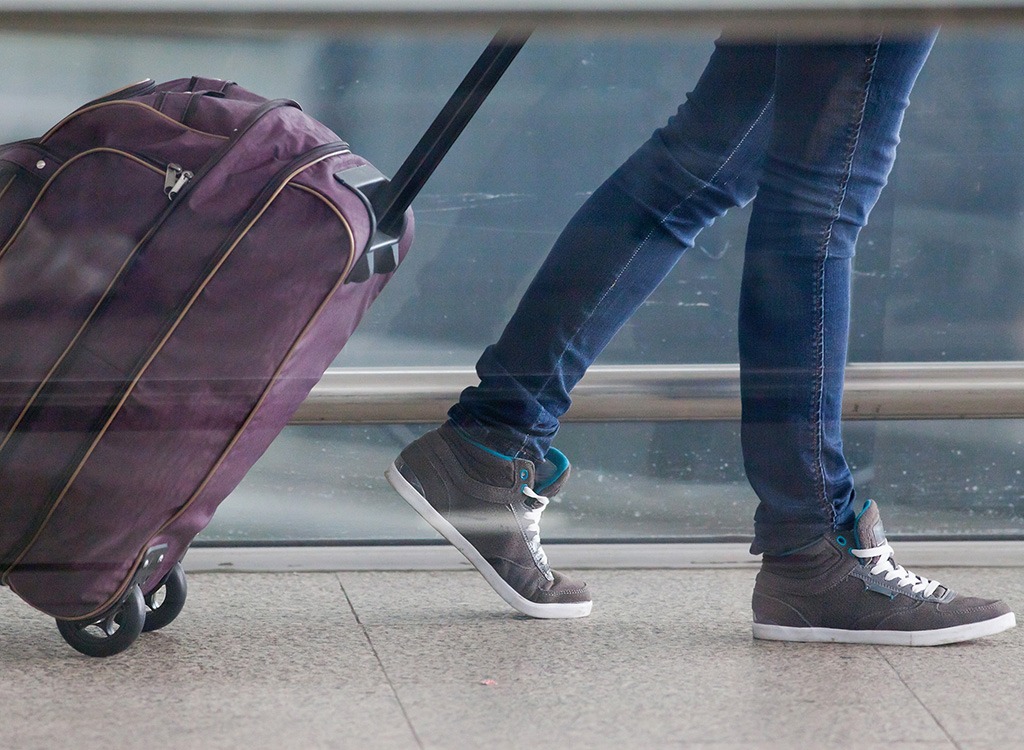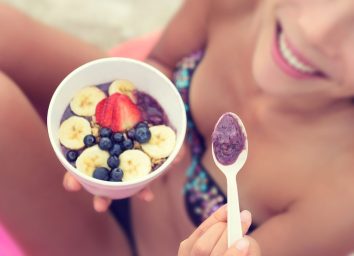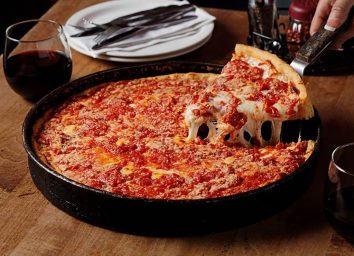TSA-Approved Foods: Exactly What You Can Bring With You on Your Next Flight

Unless you're flying first-class or international, the chances you'll be served a full meal on your next flight are pretty slim. That means it's on you to pack your own snacks because there's no chance that paltry bag of pretzels or those sugary, gooey stroopwafels served complimentary in-flight will stand a chance against the hunger pangs causing turbulence in your tummy. Oh, and if you're flying on a budget carrier, don't expect any snacks at all to be passed out for free.
The solution: Pack your own travel snacks. But, when you go this route, you've got an added challenge in determining which foods are TSA-compliant. You don't want your homemade hummus or your jar of organic peanut butter to get tossed in the trash bins at security, right?
We've done some digging and investigated which foods you can get through airport security, and which ones are on the no-fly list. We're also consulted registered dietitians to get some healthy snack ideas for your next flight.
What foods are TSA-approved?
In general, the Transportation Security Administration (or TSA) applies the same "liquids rule" to your food as it does your cosmetics. That's to say, you could technically pack chicken noodle soup—but, just like your perfume, you've got to limit it to 3.4 ounces or less, and that probably won't be enough soup to hold you over.
But, what exactly constitutes a liquid, according to TSA? You know bone broth clearly falls into this category, but TSA also considers foods with thicker consistencies (think: creamy dressings or yogurts) to be liquids, too.
Here are the foods that, if you choose to carry on, you'll need to limit to 3.4 ounces to get through security:
- Creamy cheeses
- Creamy dips and spreads
- Gravy
- Honey
- Hummus
- Ice cream
- Jam and jelly
- Maple syrup
- Oils and vinegars
- Peanut butter
- Pet food, wet
- Salad dressings
- Salsas and sauces
- Soups
- Yogurt
Let's dig into this a little more: Sandwiches and salads are OK, so it shouldn't be problematic if you've spread a little more than 3.4 ounces of peanut butter on your PB&Js or gone crazy with the oil and vinegar on a huge salad. As long as these things aren't in their own separate containers in quantities larger than 3.4 ounces, you should be good to go.
While veggies or whole fruits are usually great, healthy snack ideas, you won't be able to pack those if you're flying from Hawaii, Puerto Rico, or the U.S. Virgin Islands to the U.S. mainland because of the risk of spreading invasive plant pests, according to TSA.
But, here's a good-to-know hack: If you've got questions about whether your food will make it through security, you can simply snap a photo of your food and ask TSA officials via Facebook Messenger or Twitter.
Oh, and in case you're wondering: Yes, live lobster get the green light from TSA, but the airline might prohibit them from boarding the flight.
What about flying with baby food and kid food?
If you're traveling with young children or are bringing breast milk, TSA has some exceptions as it pertains to the liquids rule.
For example, TSA allows you to carry on the following: baby food, baby formula, breast milk, and juice. The 3.4-ounce rule does not apply to these foods; rather, TSA says it's allowed in "reasonable amounts," but doesn't get any more specific. You do not need to be traveling with your children to carry on breast milk, formula, or juice for children, according to the TSA rules. You will need to remove these items to be screened separately, however.
How to pack your food for a flight
Solid foods can be packed in your checked or carry-on bags. Liquid or "gel food items" in amounts smaller than 3.4 ounces are allowed in your carry-on bags, but if they exceed that weight limit, and if it makes sense food-safety wise, they need to go in your checked bags.
TSA loves it when you organize your carry-on bags and keep them uncluttered because it makes the screening process easier and helps keep the lines moving along. The best thing to do if you're planning to travel with food is to be able to easily separate your food items from your carry-on bags.
Keep in mind, however, that even if you do your homework and follow all of the rules that TSA has spelled out, your snacks may be subject to some scrutiny.
Most TSA-approved travel containers are designed for toiletries and cosmetics, but some, like these BPA-free silicone bottles, are advertised as being able to carry sauces.
Healthy snacks to bring on board
Now that you've figured out which foods are TSA-compliant, you're ready for your next challenge—packing healthy snacks for your flight.
Here are some snacks that Hillary Cecere, RDN of Eat Clean Bro meal prep delivery service, and St. Louis-based dietitian Kim Yawitz, RD, LD, recommend when traveling:
Fruits and veggies
"Oranges provide about 1/2 cup of water and a good dose of potassium—both of which fend off post-flight puffiness," Yawitz says. Not to mention, a medium orange has about 3 grams of fiber, which can help keep you regular when you're traveling. Cecere recommends the following fruits and veggies that travel well:
- Bananas
- Apples
- Oranges
- Baby carrots
- Grapes
- Clementines
- Tomatoes
- Celery sticks
- Kiwis
She also suggests unsweetened applesauce packs, but you'll probably have to pack your own, or find some in a store on the concourse, as most store-bought cups come in 4-ounce packs.
Nuts and nut butter packs
Just one ounce of almonds provides a satiating combination of healthy fats, protein, and fiber—all great for fighting travel munchies, says Yawitz. "They're also a good source of magnesium, which can help fend off muscle cramps and headaches," Yawitz says. Pick unsalted, raw nuts if possible because sodium is dehydrating, Cecere says. She also suggests nut butters like Justin's almond butter packets. At 1.5-ounces, they're TSA-approved, and, Cecere says, they are perfect for pairing with whole-grain crackers or a banana. You may want to eat any nut snacks while at the gate, though, in case a fellow passenger has nut allergies is on your flight.
Pre-packaged bars
"My picks are RX Bars, Larabars, or KIND bars," says Cecere. They are made with whole food ingredients like dates, nuts, seeds, and dried fruit." You can also find these easily at the airport if you forgot your snacks.
Yogurt
While you won't be able to get your yogurt parfait through TSA if it's more than 3.4 ounces, airports typically have yogurt available at most grab-and-go places, Cecere says. "Yogurt is awesome because it has probiotics, which are beneficial for immunity and digestion," she says. "I always look for Greek yogurt, preferably plain, which is higher in protein and lower in sugar."
Sandwiches
Sandwiches are always a safe bet when traveling. The key here is to load it with veggies, like many of these healthy sandwich recipes do.
Oatmeal
You could bring your own pre-packaged oatmeal, but finding a microwave would be tough. Hot oatmeal is offered at most coffee shops found in airports, Cecere says. "Oatmeal is a great high fiber breakfast option and can help prevent constipation and bloating which can happen when you travel," she says.
Grain salads
A salad with a base of quinoa, barley, or farro will travel better than a lettuce-based salad because it won't wilt. Load it with veggies like tomatoes, cucumbers, bell peppers, and olives, and top with a fatty cheese like crumbled feta, or lean protein like tuna or chicken. It will keep you full without causing extra digestive distress.
Staying hydrated on a plane
Last but not least, you'll want to make sure you're staying hydrated on board! You can absolutely pack an empty water bottle and fill it all the way up once you get through security.
"The dry cabin air in planes increases the likelihood of dehydration and, in turn, constipation, upper respiratory bugs, fluid retention, jet lag, and other discomforts," Yawitz explains. Not exactly what you want happening to your body when you touch down for vacation!
You may have heard about celebs spiking their water bottles with ginger or herbs when traveling, and asking flight attendants to fill up their infused water bottles. If it helps you consume more H2O, then great! But, Yawitz says, you can obtain more vitamins, minerals and antioxidants simply by eating whole fruits and veggies or sprinkling your salad with some herbs.








